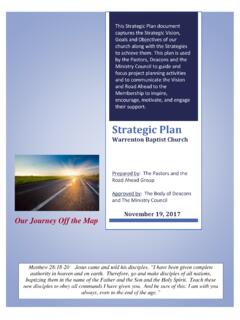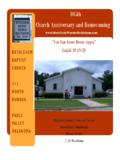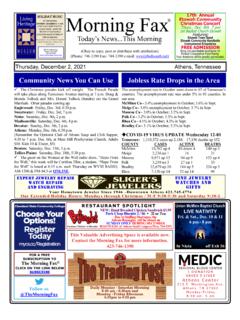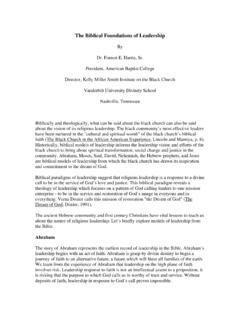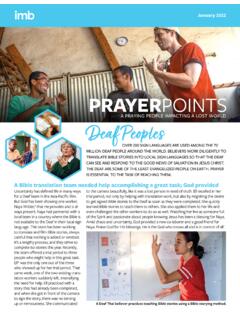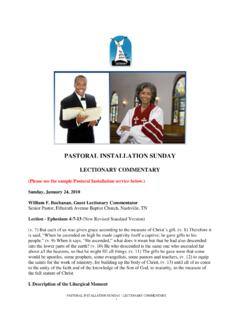Transcription of The Liturgical Year - cg.catholic.edu.au
1 1 TREASURES NEW AND OLD: THE Liturgical YEAR November,2010 Teaching and Celebrating The Liturgical Year A Resource to Complement Treasures New and Old in the Catholic Schools of the Archdiocese of Canberra and Goulburn 2 TREASURES NEW AND OLD: THE Liturgical YEAR November,2010 TABLE OF CONTENTS INTRODUCTION .. 3 ADVENT .. 5 CHRISTMAS .. 8 LENT .. 10 EASTER .. 13 PENTECOST .. 16 MARY .. 18 ORDINARY TIME .. 21 FEAST DAYS .. 21 ST MARY OF THE CROSS .. 22 HOLY DAYS OF OBLIGATION .. 22 ABORIGINAL SPIRITUALITY .. 23 EARTHCARE .. 24 SOCIAL JUSTICE .. 25 PLANNER .. 26 BIBLIOGRAPHY .. 28 3 TREASURES NEW AND OLD: THE Liturgical YEAR November,2010 Graphic Retrieved August 22, 2010 from: INTRODUCTION When we think about a year we often think of it in terms of its seasons. Each season has its particular feel, its own customs and activities that we associate with it.
2 We adapt or change according to the season. We wear different clothes, play different sports, and eat different foods. We even associate colours with different seasons. Our life journey too, can be viewed using the image of seasons. We experience seasons in the physical, social, emotional and spiritual aspects of our lives. A calendar year incorporates the seasons in twelve months or fifty-two weeks which include holidays, commemorative days and days that we could term as ordinary. The Liturgical Year is similar in the way it is organised. It provides particular occasions and whole seasons to ritualize the significant movements in our Christian life. It is through this cyclical process that the Church renews itself again and again. In the Liturgical Year every season or feast day has its own unique symbols and colour which help us to explore and be involved in the mystery of the incarnation, birth, life, death and resurrection of Jesus.
3 We begin the Liturgical Year on the First Sunday of Advent then move to Christmas, Ordinary Time, Lent, Triduum or Three Days, Easter, Pentecost and Ordinary Time again, finishing with the feast of Christ the King. The Liturgical seasons provide us with a way of looking at the same mystery from different aspects in order to learn something new each time we experience them. Year after year it invites us to deepen our relationship with Jesus. 4 TREASURES NEW AND OLD: THE Liturgical YEAR November,2010 The Scriptures take us through the Liturgical Year on a three year cycle. The Church designates readings to be used for each day on a three year cycle. We have Liturgical Years A, B and C. We look at Jesus and our own lives through the Gospel of Matthew (Cycle A), Mark (Cycle B) and Luke (Cycle C). The Gospel of John is included at particular times in all three cycles.
4 The Liturgical year is one way that we can interpret the Scriptures, enabling us to integrate our life experience with the life of Jesus. It is how we express our identity as Christians. Retrieved 13 August, 2010. Retrieved 13 August, 2010. 2011 2012 2013 2014 Sunday Cycle B C A B Weekday Cycle I II I II RESOURCES About the Catholic Faith: A general introduction Liturgy Lines Our Catholic Faith Blessed Are We Liturgical Year Liturgical Year Liturgical Colours 5 TREASURES NEW AND OLD: THE Liturgical YEAR November,2010 ADVENT Advent is the beginning of the Liturgical Year and is a time for anticipation, preparation, joy and hope . We use it to grow in our understanding of Christian joy and hope and of what we celebrate at Christmas. During Advent we celebrate and prepare to remember Jesus' entry into the world at Christmas and it is a way of preparing for the coming of Christ at the end of time.
5 It helps reveal to us what it means to have a deep concern for human well-being, for what Jesus called the "kingdom of God". (Densley 2002) The colour of Advent is violet or a shade of purple. A widespread practice during Advent is the use of an Advent Wreath. A new candle is lit on each of the four Sundays of Advent. However, it is important to note that the candle lit on the third Sunday of Advent is rose or pink symbolising joy. The candle lit on Christmas day is white. Advent calendars are often used to focus on how we prepare for Christmas. Advent: The Experience of Desire John Gallen SJ Retrieved 13 August, 2010. Densley, T, (2002). Advent and peace. Echoing the word ,1 (5)Retrieved August 16, 2010 from: SCOPE AND SEQUENCE Learn about Learn to Kindergarten Advent as a special time to prepare in prayer and action as we wait to celebrate Jesus birthday at Christmas.
6 Explain what it means to prepare or wait for something. Discuss ways that we can prepare for the celebration of Jesus birthday. Year 1 Advent, a season in the church calendar to prepare and wait for the celebration of Jesus birth at Christmas. Share experiences of preparing for a birth or a birthday celebration. Develop a class Advent calendar to prepare together. Year 2 The Church Year, called the Liturgical Year begins with the season of Advent. Mary, the mother Jesus prepared for his birth. Use a class Advent wreath to mark the passing of days in preparation for Christmas. Articulate personal actions of love that will help us prepare to celebrate Jesus birth. 6 TREASURES NEW AND OLD: THE Liturgical YEAR November,2010 Year 3 During Advent we recall the stories of Jesus life in preparation to celebrate the birth of Jesus. Advent is a time to prepare to celebrate Jesus birth by learning to live the messages of Scripture.
7 God is revealed to us through Jesus. Explain how Advent actions and promises are ways of responding to Scripture. Express personal promises in terms of how they will make life better for self and others. Year 4 Advent invites us to remember and celebrate the presence of Jesus Christ in our world. God s promise fulfilled in the birth of Jesus challenges us to live lives of love and service. Identify ways that we can live lives of love and service and use them on a personal Advent calendar. Year 5 The Church s season of Advent celebrates the coming of God s reign among us. During Advent we wait in joyful hope to celebrate the birth of the Saviour, Jesus Christ. Advent is a time to reflect on the need for God s loving presence in our world. Discuss good and evil as opposites in our world. Identify real life examples of Christ-like behaviour.
8 Describe how God s loving presence is evident in our world through acts of love and justice. Year 6 As Christians we recall the promise of God s gift of Jesus and are mindful of our mission to be witnesses to Jesus Christ in our world. Advent is a time of preparation. John the Baptist preached preparation for the coming of the Messiah, which is the Hebrew term for Christ (Anointed One). Recall how God s people prepared for the coming of the Messiah. Describe the birth of Jesus as the fulfilment of prophecy. Create a Jesse Tree and learn about the preparation through history for Jesus birth. Year 7 Advent invites us to prepare for Christmas by waking up and seeing with new eyes signs of hope around us. Use the reflective practice of the examen1 to discern the traces of God in the events of life. Year 8 Advent is a time of promise, hope and expectation.
9 Study the sequence of the Advent gospels and their meaning. 1 The Examen is a daily practice to review the happenings of the day in order to be aware of God s action. A simple version that is helpful for children has been developed by Linn et al (1995) and uses the question Where did I give and receive the most love today? 7 TREASURES NEW AND OLD: THE Liturgical YEAR November,2010 Year 9 Advent prepares for the commemoration of Jesus Christ s birth and looks forward to the fulfilment of God s Reign. Write prayers for use within the school during Advent that fit the form of those used in the Year 10 Advent is the beginning of the Church Year. Examine Church calendars in detail and create an accurate school calendar for the year ahead that includes relevant feasts etc. Years 11-12 During Advent we wait in joyful hope to celebrate the birth of the Saviour, Jesus Christ.
10 Develop a list of ways that teenagers can include the Christian perspective in Advent and Christmas. RESOURCES The Jesse Tree Blessing the Christmas ornaments Advent Calendar 2 The Sacramentary is a book that contains the prayers for the celebration of Mass. Different prayers are nominated for feastdays and for each week of the Church year. 8 TREASURES NEW AND OLD: THE Liturgical YEAR November,2010 CHRISTMAS During the Christmas season we celebrate the birth of Jesus Christ. It includes the Feast of the Holy Family, The Feast of the Mother of God and concludes with the Epiphany (the day when we celebrate that Christmas happened for everyone). It is the season where we focus our lives on reaching out to others in peace and goodwill. We use white, the colour of purity and new life for Christmas.
